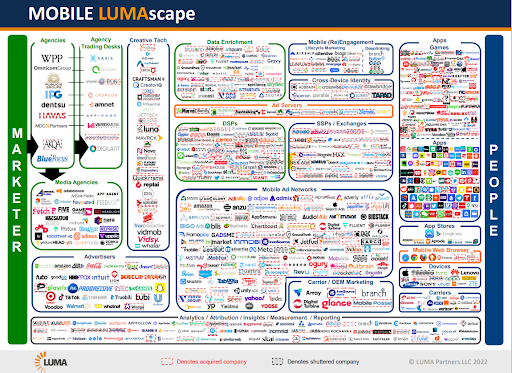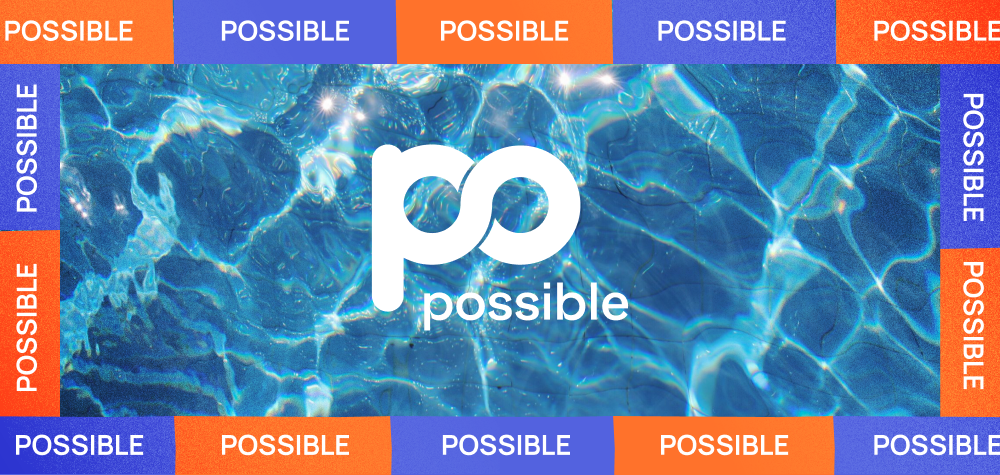In the 19th century, multitudes of prospectors flooded newly discovered goldfields, eager to stake their claim on the fortunes to be made.
It was known as the Gold Rush.
In the 21st century, the internet is the gold mine and the ‘rush’ is all the players in the digital advertising supply chain who have flooded the ecosystem. These include DSPs and SSPs, trade desks, data providers, agencies, retargeting platforms, and more. The big promise of programmatic advertising was to restore order and automate this enormous system, making it more simple and efficient. However, nothing could quell the explosive growth and the added complexity that came with it: between 2017 and 2023, programmatic ad spend worldwide was expected to triple, from $187 billion to nearly $558 billion.
The mobile industry faces a similar dilemma. Indeed, a glance at a map of the mobile advertising ecosystem proves just how overloaded it has become.
Source – Luma
As mobile use continues to explode, so does the demand and supply for mobile ad inventory. In recent years, a new approach has come into the picture. It aims to scale back the complexity of media trading while scaling up the reach and performance of targeting and campaigns. It uses data curation AI and content curation tools to add value to the programmatic ecosystem while maintaining data privacy and brand safety. It’s called programmatic curation, and it is already making an impressive mark on performance and revenue for advertisers and publishers.
What is Programmatic Curation & Why it Matters
Programmatic curation is a process in which digital ad supply is ‘curated’, or packaged, into supply portfolios, made available as private deals via any DSP. While programmatic media buying is based on targeting audiences across app inventory, curation pairs data to inventory, enabling advertisers to gain far more added value from their programmatic media buys.
During the curation process, the curator, which could be publishers, SSPs, ad networks, or data providers, uses AI to screen media supply and data. It is then packaged together in bundles that are available for activation much earlier in the programmatic supply chain. These curated packages are typically based on some form of unique value that the SSP can provide to media buyers.
Start.io’s audience segments, for example, are based on first-party proprietary data from the platform’s vast mobile user network, offering high-value curated supply for mobile advertisers across a wide range of niches and locations.
Curation is a much-needed antidote to the increasing complexity of the programmatic supply chain. As the programmatic ecosystem has evolved, more intermediaries have entered the play, obscuring transparency and weighing down the efficiency of the programmatic buy-sell process.
With curation, ad inventory and audience data are connected on the supply side, removing many of the layers in the programmatic trade and supporting a smooth path to effective digital supply and audience targeting at scale.
The Evolution of Programmatic Advertising: From Automation to Curation
When programmatic advertising was first developed around a decade ago, it promised to simplify the complex processes of buying and selling ad inventory online. For the first time, publishers and advertisers could engage in real time, automated auctions for digital ad space, enabling both parties to benefit. With automation, digital media buying would become faster, more efficient and transparent, opening up publishers to new avenues of monetization, and enabling advertisers to scale their campaigns and optimize costs with minimal manual effort.
While automation has proven its immense benefits, the programmatic supply chain has become so complex that much of the transparency and efficiency has been lost. In a study by the UK’s ISBA, it was revealed that around 15% of advertiser spend in the programmatic supply chain is unaccounted for. At the same time, publishers receive only around 51% of advertiser spend.
It is time for the ecosystem to evolve once again, and restore the direct, efficient and transparent approach that programmatic has always promised. By around 2021, that change began to happen with the advent of programmatic curation.
What are the Benefits of Programmatic Curation?
Despite the ambitions of the programmatic ecosystem to streamline digital media buying and make it more efficient and cost effective, there are in fact a lot of intermediaries between advertisers and publishers in the supply chain. These tend to complicate the process, making it more opaque and driving up costs.
With so many players trying to get a cut, curation aims to pre-package curated inventory supply, enabling advertisers to directly buy and activate highly-suitable deals from SSPs, without having to rely on expensive and unnecessary middlemen.
Here are the top 7 benefits that this new paradigm of programmatic curation provides:
- Adds value to the programmatic supply chain: With data curation, buyers get the unique value of ready-made inventory deals based on a combination of first-party data and ad inventory. Ad inventory can be curated in many ways, based on the unique offering of the data provider or SSP, such as consumer segments, proprietary data, preferential access for rates or publishers, and more.
- Returns control to advertisers over their media buying: With curated supply portfolios, buyers can optimize their path to supply, and choose curated deals according to the factors and characteristics that are most valuable to them, such as consumer interests, brand values, publisher rates and more.
- Alleviates issues of cookies and data privacy: With cookie depreciation and changes to mobile advertising privacy, such as Apple’s IDFA and Google’s Advertising ID, curation offers an effective alternative for audience targeting. Curation provides advertisers with access to first-party data in the form of powerful curated supply plans that combine inventory and audience targeting together, without any reliance on PII (Personally Identifiable Information).
- Boosts transparency: Curation offers a single path to supply for advertisers, rather than bidding across numerous platforms for a particular supply or data-based segments. This is critical to tracking ad spend and monitoring ROI of advertising investments.
- Improves agency operations: For agencies, curation enables centralization of digital media buying for their clients. By cutting back on supply pathways, agencies can boost their operational efficiency, at the same time offering unique and differentiated buying strategies to advertisers.
- Enhances data monetization for publishers: Curated data is the basis for new audience segmentations and monetization opportunities for publishers. Curation enables publishers to connect their inventory to audience data, boosting the attractiveness of their supply and maximizing their revenue potential.
- Rebuilds relationships between advertisers and publishers: After a decade of programmatic advertising, the ecosystem has become murky and convoluted, and media buyers and sellers have moved further apart. Via curated deals, advertisers and publishers can remove the intermediaries and return to building direct relationships and working together. This significantly reduces the workflow, making the path to supply more efficient, transparent and beneficial to both sides of the deal.
The Challenges and Limitations of Programmatic Curation
As with all forms of online targeting based on machine learning and algorithms, curated data comes with the risk of filter bubbles. Filter bubbles occur when users are targeted with similar content or ads, exposed to the same messages over and over. As AI and algorithm-based targeting improve, this will surely change, however for the time being, this is still a challenge for programmatic curation.
Curation is a relatively young methodology, so there is still a lot of noise around new curation tools and how to use them. Advertisers should focus on connecting with trusted partners who offer curated supply and can help ease them into the curated marketplace. By leveraging curated data from experienced and respected providers, advertisers can get the assurance of brand safety and privacy compliance while also reaping the benefits of programmatic curation.
SPO (Supply Path Optimization) has been the buzzword for the past few years, as advertisers culled large parts of their supply and removed inventory and resellers in an attempt to make the process more lean and straightforward. However, this approach was dull-edged, removing too much quality and value of supply inventory in the process. As the world adapts to the realities of AI, and its enormous (and sometimes frightening) potential, intelligent curation will emerge as the inevitable – and far better performing – alternative.
AI and Machine Learning in Programmatic Curation
Much of the criticism of programmatic advertising is due to the lack of transparency and efficiency – what was supposed to be a smooth automated process of buying-selling of digital media transformed into a complicated web of tools, platforms and hidden middlemen.
While curated supply helps restore the direct relationship between ad buyers and sellers, it still relies on automation. Even more, it is based on AI and machine learning that enables intelligent curation, and supports the powerful capabilities for predictive analysis, optimization and personalization of supply in real time.
Indeed, programmatic curation relies on machine learning models that are constantly scanning and analyzing audience data and inventory performance, to create the best possible curated supply. As these ML models become smarter and more sophisticated, so too the media sellers can provide even more precise and appealing curated packages for advertisers at scale, vastly increasing their potential revenue.
By accurately tailoring AI algorithms to the inventory, goals and parameters of specific publishers, sellers can provide immense added-value to advertisers, rather than simply being yet another avenue for automated bidding. By making the programmatic process simpler, more efficient and transparent, AI and ML are the true power of programmatic curation.
Best Practices for Implementing Programmatic Curation in Your Advertising Strategy
While intelligent curation is already here, the convoluted nature of the programmatic advertising process makes it hard for advertisers to discern the best path forward. Here are some best practices to make the most of programmatic curation as part of your advertising strategy:
Think of curation as an addition to your toolbox
Curation is not a replacement for programmatic; rather, it is an additional strategy to include in the programmatic buying process. One of the huge benefits of the curated marketplace is that publishers and curators can create supply portfolios based on their unique offering or proposition. For advertisers, this provides a highly valuable tool to incorporate into your existing strategy.
Make the mindset shift to include curation in your arsenal and start experiencing the rewards.
Expand your targeting mentality
Curated content tools open up a world of audience targeting options, whether it be consumer segments, interest targeting and more. For instance, curated inventory packages can focus on issues that support an advertiser’s values, such as sustainability or diversity. This provides media buyers with the option to align more closely with publishers and inventory that reflects the brand’s values.
Publishers and curators will be constantly looking for ways to differentiate their curated supply packages, so advertisers should use curation to expand their approach and get creative about targeting.
Explore your options
The curated marketplace is still in its early years, and as third-party cookies decline, advertisers will be chasing first-party data and identity solutions wherever they can. With curation, advertisers and publishers can explore and test which curated deals are performing well and which audiences and IDs are worth investing in. Testing and experimentation is always key to programmatic advertising; now is the ideal time to really explore all the options with curation as the ecosystem unfolds and expands.
Work with trusted partners
Brand safety, ad fraud and transparency will always remain crucial factors in the programmatic supply chain. Curation provides important safeguards that offer peace of mind for both advertisers and publishers. For media traders already working with trusted advertising partners, find out whether they offer curated supply. If they do, this is the ideal opportunity to access fast, effective supply deals and increase your performance and safety even further. Fortunately, SSPs make it very easy for advertisers to take advantage of built-in curation services – simply activate the curated supply with your current supply partners who offer it with just a few clicks.
Get smarter about spending
Programmatic curation connects ad buyers and sellers in a simpler, more direct and transparent supply chain. By centralizing media trading in a single supply path, it is much easier to see a holistic picture of ad spending across all platforms and publishers. This supports a simpler approach to reporting across campaigns, and for agencies, across brands and clients too.
With increased transparency, all parties can better track and monitor their investments, and gain insights to make smarter decisions.
Programmatic Curation Ethics: Balancing Personalization with Privacy
Programmatic advertising has always walked the tightrope between personalization and privacy, delivering tailored ad experiences to users while complying with ever-tightening data privacy laws.
Curation is a new tool that helps achieve that balance.
Curation bypasses cookies and other third-party identifiers that are slowly being regulated away, giving advertisers access to supply portfolios based on first-party audience data paired with high quality ad inventory.
Curation makes it possible for data providers to stay relevant in a market focused on privacy and first-party data, by enabling them to implement their third-party assets in high quality deal IDs with any DSPs. For publishers, programmatic curation opens up a world of options for data monetization and new audience extensions, without having to worry about data privacy compliance or safety issues.
While over 60% of publishers are concerned about third-party cookie depreciation, only about 25% have a solution in place. For the mobile industry, the introduction of Apple IDFA and Google Advertising ID has already put the data privacy wheels into motion. Programmatic curation of privacy-compliant first-party data with high-quality mobile publisher inventory will be the key to balancing personalization and privacy in the cookieless future.
The Future of Programmatic Curation
Programmatic curation in the mobile advertising ecosystem is the new wave of efficiency and transparency, and is poised for significant growth. As mobile continues to dominate digital interactions and user experiences, the curated marketplace will play a crucial role in delivering highly personalized and relevant ads to mobile users – even as privacy laws tighten and third-party identifiers disappear.
Advancements in AI and machine learning models will continue to fuel the evolution of a curated-based system. Data curation AI technologies will enable more sophisticated algorithms to analyze vast amounts of data, including location, behaviors, devices, interests, and other contextual signals, to deliver hyper-targeted and contextually relevant ads at scale. For media buyers and sellers, curation enables this superior level of personalization, which is so vital to user engagement and conversion rates, while ensuring a simpler, more efficient, more transparent process.
The end result? A new way to optimize the programmatic supply chain, ensuring better ROI for advertisers and improved publisher monetization.
Visit Start.io Curation page to learn more and start curating with Start.io.




